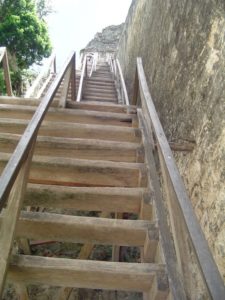 Seven years ago I took an amazing trip to Guatemala. In addition to some time spent volunteering at Cedepca, my friend Dania and I took a vacation north to the highland region of the country.
Seven years ago I took an amazing trip to Guatemala. In addition to some time spent volunteering at Cedepca, my friend Dania and I took a vacation north to the highland region of the country.
Part of this trip included a visit to Tikal, incredible ruins nestled in the rainforest which was the capital of a conquest state that became one of the most powerful kingdoms of the ancient Maya with architecture that dates back as far as the 4th century BCE. Similar to the pyramids in Egypt in scale, Tikal is larger than life and almost unbelievable. We soon found ourselves at one of the largest temple ruins, Temple 5, where visitors were invited to climb to the top.
Dania quickly dismissed the idea, but I jumped at what I imagined might be a one-in-a-lifetime opportunity. She agreed to wait and held my bag as I made my way to the base. Because the steps were very narrow and worn, the only way up and down was a wooden staircase that was more like a ladder, affixed to the crumbling ruins.
I began to climb. The structure began to shake. I looked up, following many tourists who were ahead of me. My grip tightened. The ladder creaked. About halfway up, the movement on the stairs slowed and my stomach got pretty heavy. Then I made a critical mistake – I looked down. I have a relatively healthy fear of heights, and in just a few moments convinced myself that this was the most foolishly dangerous thing I could have ever possibly done, and surely I was moments away from slipping and falling without anything to stop me but the people and stones below. I became almost paralyzed with fear. But I was also in the middle of a ladder with nowhere to go but up.
So I held on for dear life, praying I could figure something out. Then, I noticed something ahead of me at the top of the stairs. An older gentleman was being encouraged by his family to complete his climb. With their help, he reached the top, and then, pressed tightly against the wall of the ruins, began to encourage me. He helped me take the last few steps, and then find a spot next to him where I wouldn’t fall off the ledge and could take in the view. 

In moments, he had become my best friend. He shared how important it was to him to follow his grandchildren up and take in this sight. He was 70 years old, but this was his first visit to Tikal. We marveled at the view, and at the people down below. We discussed how we could avoid having to go back down those wooden stairs. The storm inside me calmed. And eventually, with his encouragement again, I was able to return safely to the ground. We celebrated together.
Moments that take us outside of our comfort zone have the potential to be exhilarating moments that are exclamation points on the adventures of our lives. Our gospel reading today is not exception, featuring an overeager, passionate disciple who makes a pretty dramatic leap.
Peter is perhaps the most enthusiastic disciple. When Jesus asks for something to happen, it is Peter who has his hand up first to volunteer. He may not get it right all of the time, ok, a lot of the time, but his effort is inspiring. He is what we might describe as being “on fire” for the Lord, and he wants to be a part of everything that Jesus is doing right away. You know how dogs get all excited when their owner comes home, racing towards them with tails wagging? That’s Peter when he sees Jesus coming on the water.
To be sure, Peter’s decision to jump overboard was pretty foolish, particularly in the midst of a storm. It’s the very definition of “throwing caution to the wind.” As Pastor Andrew Foster Connors notes:
You do not step out of a boat in the middle of a storm. You batten down the hatches, put on your life jacket, hunker down in the belly of the boat, and pray that the waves do not get any bigger and the winds to not get any stronger. . . . The safest way to avoid getting hurt seems to be to stay in the boat: 92 percent of the disciples do exactly that in this story[i].
Most of us would stay in the boat, too. And in this way, the boat becomes a metaphor for how we try to keep ourselves safe, comfortable, and sheltered, particularly when things are rough. Our boats are numerous, and they are literal and physical as well as spiritual. Writer and Pastor John Ortberg identifies them to us in this way, saying:
Your boat is whatever represents safety and security to you apart from God himself. Your boat is whatever you are tempted to put your trust in, especially when life gets a little stormy. Your boat is whatever keeps you so comfortable that you don’t want to give it up even if it’s keeping you from joining Jesus on the waves. Your boat is whatever pulls you away from the high adventure of extreme discipleship[ii].
Most of us would stay in the boat, but not Peter. Peter embraces the call to discipleship and hears Jesus’ invitation to come. He anticipates that something exciting is going to happen. And, like a child standing on the side of a pool wanting to jump in, he yells out to Jesus “are you ready?” asking permission to take the leap. Jesus responds with a simple command, “Come,” urging Peter to join him. And that simple invitation is all it takes to get Peter walking on water.
What would it take for you to walk on water with the Lord? That is one of the questions John Ortberg asks in his popular book. In it, he offers that God often calls us to get out of the boat in a variety of ways, and he identifies four indicators that can help us identify God’s call and motivate us, too, to get out of the boat.
First, he identifies the indicator of fear. Those things that cause us the most anxiety and nervousness, he argues, might be the places God is most calling us to grow. Second, he suggests an indicator of frustration in our lives that comes with the gap between the fallen reality and our sense of God’s desires. These are the moments where we might be prompted to action as we try to reconcile the world as it is with the world as we believe God intends. Third, there is the indicator of compassion, those things that tug at our heart strings and compel us to respond with demonstrations of love and care for one another, both strangers and friends. Finally, he speaks of the indicator of prayer, recognizing that we may not always see the path clearly, but that through prayer we might uncover deeper understanding. He suggests a minimum of a six month daily commitment to prayer as a way to invite reflection and discernment. All of these indicators work both individually and together to help us get a sense that there is some presence, the one we know to be Jesus himself, who desires that we get out of the boats we have constructed for ourselves and instead try to walk on water.
Yesterday, in Charlottesville, Virginia, thousands of people were motivated to get out of their boats of comfort and speak out in the face of hate and injustice. Among them were hundreds of clergy and other Christians who joined together to bring message of hope and light to the darkness on display by those who were gathering in outrageous displays of the sin of racism and white supremacy. As I watched the news unfold, I was numb. I heard stories and saw countless pictures and videos, some of which were from seminary classmates and colleagues who were sharing them firsthand, and my heart became heavy. It was a day full of sobering moments. I firmly believe they were doing the work of witness, the kind of get out of the boat discipleship work that Jesus calls us to do. And at the same time, I found myself glad to be so many miles away, distanced from the reality of it being a decision I would make myself. I would like to think that if this had happened here in Acworth, or Marietta, or Atlanta, that I would have gotten out of the boat and been there, too. But just the thought of it engulfs me with a sense of fear that might have kept me silenced and on the sidelines. But then I read Peter’s story again, and hear Jesus calling us out of the boat, even in the midst of a storm. Brothers and sisters in Christ, the storm of racism in our country is real, and it is not just isolated to Charlottesville, Virginia. We must be attentive to the calls placed on us to get out of our boats and dispel hate with that love of Jesus that does not discriminate or favor. Overcoming fear, naming frustrations with broken systems, speaking with compassion, and praying can motivate us into active work in Jesus’ name. We must look outside the boat and see where Jesus is calling us to go. There is work for each of us to do.
Stories like this put us on the edge, and prompt us to action. Getting out of the boat means taking a risk, trusting in something bigger than we can see, in a radical act of discipleship. But doing so can be terrifying, as illustrated on the silver screen almost twenty years ago by Harrison Ford in the classic Indiana Jones trilogy. Consider this, the final of 3 tests as Indy seeks the Holy Grail as he tries to save his father’s life:
Getting out of the boat is a leap of faith. Fortunately, we aren’t just stepping off into thin air, nor are we being completely thrown in the deep end without help. Jesus is there, calling to us and encouraging us to step out. And if we get scared and start to sink, Jesus is there to hold us up so that the waters will not overwhelm us. After all, he is the one who has come to us saying, “don’t be afraid,” for the great I AM, the one who spoke over the waters of creation, through the burning bush, in the words of the prophets, has also come to us in the flesh, and over and over again demonstrates the power over the chaos that threatens to consume us. Jesus doesn’t just appear when the waters have been calmed; Jesus has the power to walk with us over the stormy waters, and gives us the abilities to do things beyond anything we could ever imagine. And all of this is possible with just a little bit of faith. The little faith that is the size of a mustard seed and can still move mountains (see Matthew 17:20). The little faith that gets Peter, and us, out of the boat. Looking to Jesus, may we be willing to take a step overboard. Amen.
~Rev Elizabeth Lovell Milford
August 13, 2017
————————————————————————————–
[i] Andrew Foster Connors, “Pastoral Perspective: Matthew 14:22-36,” Feasting on the Gospels, Matthew, Volume 2, Chapters 14-28, Cynthia A. Jarvis and E. Elizabeth Johnson, editors, (Louisville, KY: Westminster John Knox Press, 2013).
[ii] John Ortberg, If You Want to Walk on Water You’ve Got to Get Out of the Boat, (Zondervan, 2001).








Leave a Reply
You must be logged in to post a comment.